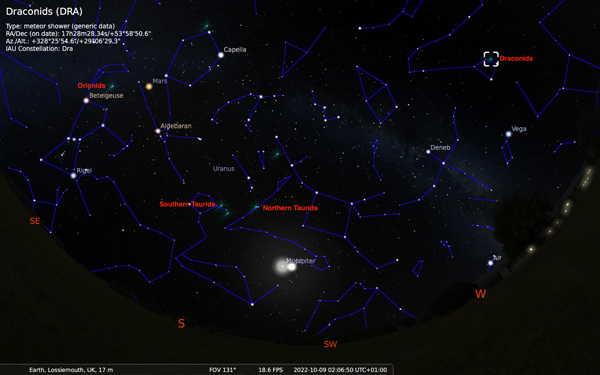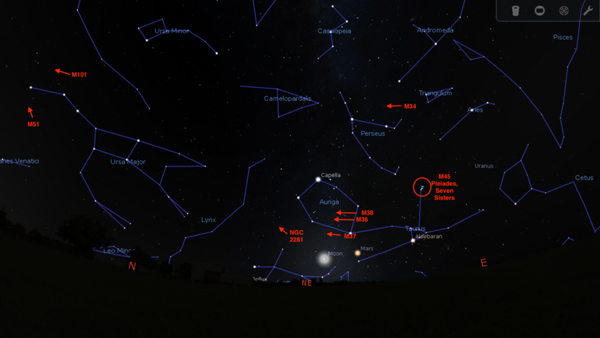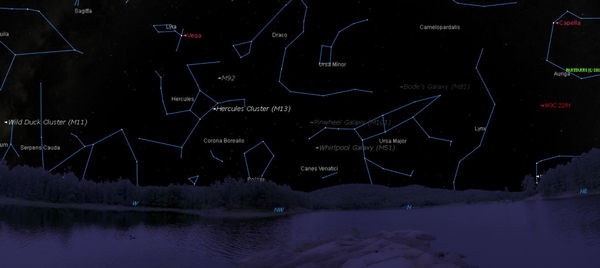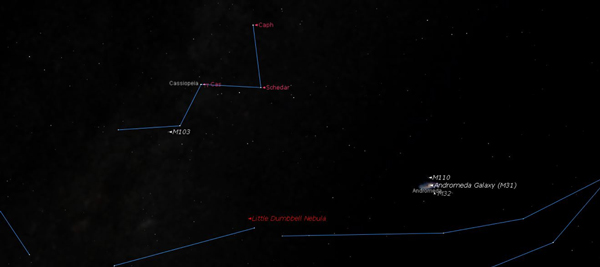Moray Sky at Night
October 2022

Moon Phases October 2022
First quarter: 3rd October
Full Moon: 9th October
Last quarter: 17th October
New moon 25th October
Image courtesy of https://moonphases.co.uk
The Planets
Mercury
At greatest western elongation at Mag -0.6 on 8th October ‘22.
Venus
Close to the Sun and comes to superior conjunction on 22nd October. It is occulted by the Moon on 25th October but the event occurs in daylight.
Mars
In Taurus, brightening from Mag -0.6 to -1.2 over the month. Begins retrograde motion on 31st October ’22.
Jupiter
After opposition in September, is still retrograding in Pisces at Mag -2.9 to -2.8.
Saturn
Retrograding slowly in Capricornus and resumes direct motion on 23rd October ‘22.
Uranus
Retrograding in Aries at Mag 5.7.
Neptune
In Aquarius at Mag 7.8.
MORAY’S NIGHT SKY – 15th October 2022 @22:00 hrs BST
Thanks to Chris Peat at Heavens-above.com for use of the star map
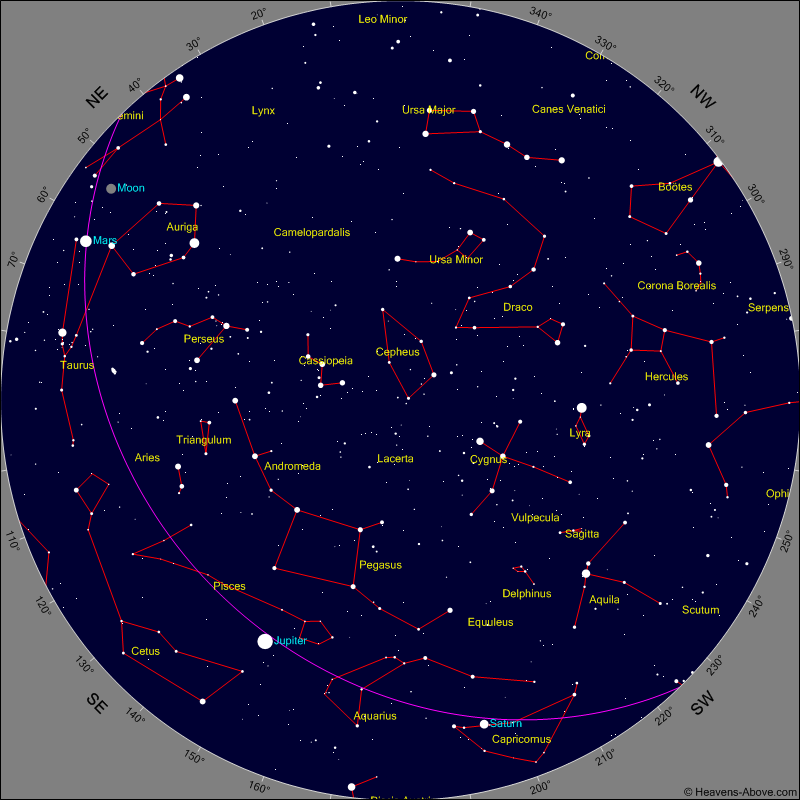
Meteor Showers
The Orionids are the major and fairly reliable meteor shower in October. Like the May h-Aquariid shower, the Orionids are associated with Comet 1P/Halley. During this second pass through the stream of the comet, slightly fewer meteors are seen than in May, but conditions are more favourable. In both showers the meteors are very fast and many leave persistent trains. The maximum is on 21st October although there is a very broad maximum, lasting about a week and roughly centred around that date, with hourly rates in the region of 25. Occasionally, rates are higher at around 50-70 per hour. This year, the Moon is a waning crescent, so conditions are reasonably favourable.
The faint shower of the Southern Taurids peaks on 10th October. The maximum occurs one day after Full Moon, so conditions are pretty unfavourable compared to the Orionids.
Towards the end of the month (around the 20th) the Northern Taurids begins to show activity, which peaks early in November.
The parent comet for both Taurid showers is Comet 2P/Encke. The meteors in both Taurid showers are relatively slow and bright.
A minor shower, the Draconids, starts on 6th October, peaking on 8-9th.
(Click image for larger view)
October Overview
Northern Sky
Ursa Major is grazing the horizon in the north, while overhead are the constellations of Cepheus and, Cassiopeia and Perseus, with the Milky Way between Cepheus and Cassiopeia at the zenith. Auriga is now clearly visible in the east, as is Taurus with the Pleiades, Hyades and orange Aldebaran. Also in the east, Orion and Gemini are starting to rise clear of the horizon.
The constellations of Bootes and Corona Borealis are now essentially lost to view in the northwest and Hercules is also descending towards the western horizon. The three stars of the Summer Triangle are still clearly visible, (made up from the three brightest stars of Vega in Lyra, Deneb in Cygnus and Altair in Aquila) although Aquila and Altair are beginning to approach the horizon to the west. Towards the end of the month (30th October ‘22) Summer Time ends in Europe, with Britain reverting to Greenwich Meantime (GMT) and Europe to Central European Time.
Southern Sky
At this time of the year we see to the south the late-Summer early-Autumn constellations of Capicornus and Aquarius. As we lose the Summer ones of Ophiuchus and Sagittarius in the west. Then later in the evening we start to see the constellations of Gemini, Taurus, and Orion, a sure sign that winter is just around the corner.
For the enthusiast of open clusters there is plenty of choice in and around Auriga. Apart from the familiar trio of M36, M37 and M38 there are a number of NGC objects, the brightest of which is NGC 2281 an open cluster at magnitude +5.4.
Towards the south we find the large but indistinct shape of Cetus (just rising on the main star chart) on the meridian, whilst above it the two fish of Pisces envelope the east and south of Pegasus. Cetus is home to Mira ‘The Wonderful’, also known as omicron Ceti and one of the earliest variable stars to be discovered. With a period of 332 days, not only does its brightness vary, but its brightness at successive maxima and minima also varies. The magnitude range is from +3.5 to +9 (too faint to see with the eye; for reference, in a dark sky, the unaided eye can barely detect a magnitude 6 star).
The latest maximum brightness was predicted to be on 16th July ’22. Andromeda straddles the meridian, with M31 – and its two immediately attendant satellite galaxies – at an enviable altitude of 80°.
Looking west, that area of sky is dominated by the Summer Triangle although it is well past its best, with Altair(the closest to the horizon) being just 18° from setting. North of Aquila lies Cygnus and between the two birds can be found the small constellations of Sagitta (the arrow) and Vulpecula (the fox).
The former has few deep sky objects within easy reach of amateur telescopes, with M71 – a globular cluster at magnitude +8.5 – being the brightest. There are also a number of planetary nebulae which range from 10th to 12th magnitude. Vulpecula has more of interest including, of course, the asterism known as ‘The Coathanger’ or, more properly, Collinder 399. There are a number of open clusters, the brightest of which is NGC 6885 at mag +6.00, but no easily observable galaxies due to Vulpecula’s proximity to the galactic plane. There is one planetary nebula, M27, but at mag 7.6 it would benefit from the application of an aperture around 250mm.
At this time of year, the Milky Way appears almost due west on the horizon and passes through this area, providing rich pickings for those who take pleasure from scanning with nothing more than a pair of binoculars.
The northern horizon sees Ursa Major close by as it straddles the meridian below the pole. The angle of the Bear’s tail tells us that Arcturus is below the horizon with most of Hercules soon to follow, although from the the UK, M92 – the strong man’s no.2 globular cluster – is just circumpolar.
The position of the Bear also tells us that Cassiopeia must be on the meridian, and she does in fact at this time have the zenith within her boundaries. This make it a perfect time to look at the many open cluster, my favourite of which is NGC457, The owl or ET cluster. So called as it looks like on owl or ET from the 1982 Spielburg film. Close to Cassiopeia is this months Object Challenge, (M76) The Little Dumbbell Nebula.
October’s Object Challenge
(M76) The Little Dumbbell Nebula , (*Planetary Nebula). The nebula lies at an approximate distance of 2,500 light years from Earth and has an apparent magnitude of 10.1.
Large binoculars and small telescopes show M76 as a small, diffuse point of light. The nebula is better seen through medium-sized telescopes. 8-inch telescopes reveal its two lobes and the dark lane separating them, while large instruments show both the double-lobed structure of M76 and the faint halo surrounding it.
*Planetary nebula, any of a class of bright nebulae that are expanding shells of luminous gas expelled by dying stars. Observed telescopically, they have a relatively round compact appearance rather than the chaotic patchy shapes of other nebulae.
International Space Station (ISS)
From 17th September until 3rd October ’22, the ISS is an evening object. Then there are no visible passes of the ISS until the 22nd October, when it will be a morning object until the 6th November ’22.
For more info go to https://www.heavens-above.com/PassSummary.aspx?satid=25544
For up to date timings and maps, if you make a free account at Heavens Above and enter your location it gives you a precise timing and starmaps.
Clear Skies!
Mick

